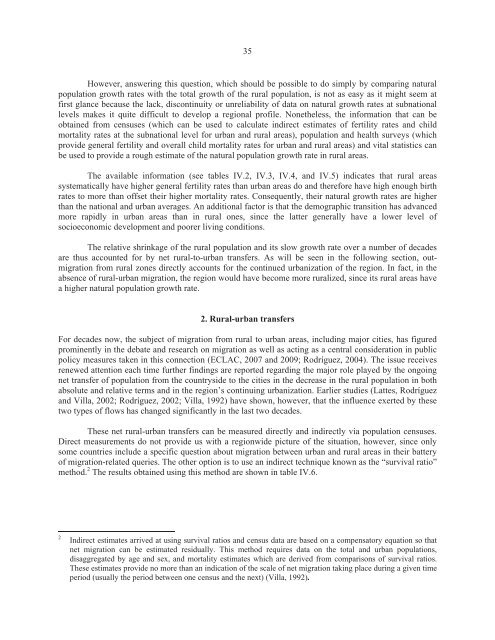Population, territory and sustainable development
The purpose of this document is to provide an overview of current trends, contexts and issues in the spheres of population, territory and sustainable development and examine their public policy implications. Three themes run through the report. The first two are laid out in the empirical chapters (III through X); the third is taken up in the closing chapter. Using the most recent data available (including censuses conducted in the 2010s), the first theme describes and tracks location and spatial mobility patterns for the population of Latin America, focusing on certain kinds of territory. The second explores the linkages between these patterns and sustainable development in different kinds of territory in Latin America and the Caribbean. The third offers considerations and policy proposals for fostering a consistent, synergistic relationship between population location and spatial mobility, on the one hand, and sustainable development, on the other, in the kinds of territory studied.
The purpose of this document is to provide an overview of current trends, contexts and issues in the spheres of population, territory and sustainable development and examine their public policy implications. Three themes run through the report. The first two are laid out in the empirical chapters (III through X); the third is taken up in the closing chapter. Using the most recent data available (including censuses conducted in the 2010s), the first theme describes and tracks location and spatial mobility patterns for the population of Latin America, focusing on certain kinds of territory. The second explores the linkages between these patterns and sustainable development in different kinds of territory in Latin America and the Caribbean. The third offers considerations and policy proposals for fostering a consistent, synergistic relationship between population location and spatial mobility, on the one hand, and sustainable development, on the other, in the kinds of territory studied.
Create successful ePaper yourself
Turn your PDF publications into a flip-book with our unique Google optimized e-Paper software.
35<br />
However, answering this question, which should be possible to do simply by comparing natural<br />
population growth rates with the total growth of the rural population, is not as easy as it might seem at<br />
first glance because the lack, discontinuity or unreliability of data on natural growth rates at subnational<br />
levels makes it quite difficult to develop a regional profile. Nonetheless, the information that can be<br />
obtained from censuses (which can be used to calculate indirect estimates of fertility rates <strong>and</strong> child<br />
mortality rates at the subnational level for urban <strong>and</strong> rural areas), population <strong>and</strong> health surveys (which<br />
provide general fertility <strong>and</strong> overall child mortality rates for urban <strong>and</strong> rural areas) <strong>and</strong> vital statistics can<br />
be used to provide a rough estimate of the natural population growth rate in rural areas.<br />
The available information (see tables IV.2, IV.3, IV.4, <strong>and</strong> IV.5) indicates that rural areas<br />
systematically have higher general fertility rates than urban areas do <strong>and</strong> therefore have high enough birth<br />
rates to more than offset their higher mortality rates. Consequently, their natural growth rates are higher<br />
than the national <strong>and</strong> urban averages. An additional factor is that the demographic transition has advanced<br />
more rapidly in urban areas than in rural ones, since the latter generally have a lower level of<br />
socioeconomic <strong>development</strong> <strong>and</strong> poorer living conditions.<br />
The relative shrinkage of the rural population <strong>and</strong> its slow growth rate over a number of decades<br />
are thus accounted for by net rural-to-urban transfers. As will be seen in the following section, outmigration<br />
from rural zones directly accounts for the continued urbanization of the region. In fact, in the<br />
absence of rural-urban migration, the region would have become more ruralized, since its rural areas have<br />
a higher natural population growth rate.<br />
2. Rural-urban transfers<br />
For decades now, the subject of migration from rural to urban areas, including major cities, has figured<br />
prominently in the debate <strong>and</strong> research on migration as well as acting as a central consideration in public<br />
policy measures taken in this connection (ECLAC, 2007 <strong>and</strong> 2009; Rodríguez, 2004). The issue receives<br />
renewed attention each time further findings are reported regarding the major role played by the ongoing<br />
net transfer of population from the countryside to the cities in the decrease in the rural population in both<br />
absolute <strong>and</strong> relative terms <strong>and</strong> in the region’s continuing urbanization. Earlier studies (Lattes, Rodríguez<br />
<strong>and</strong> Villa, 2002; Rodríguez, 2002; Villa, 1992) have shown, however, that the influence exerted by these<br />
two types of flows has changed significantly in the last two decades.<br />
These net rural-urban transfers can be measured directly <strong>and</strong> indirectly via population censuses.<br />
Direct measurements do not provide us with a regionwide picture of the situation, however, since only<br />
some countries include a specific question about migration between urban <strong>and</strong> rural areas in their battery<br />
of migration-related queries. The other option is to use an indirect technique known as the “survival ratio”<br />
method. 2 The results obtained using this method are shown in table IV.6.<br />
2<br />
Indirect estimates arrived at using survival ratios <strong>and</strong> census data are based on a compensatory equation so that<br />
net migration can be estimated residually. This method requires data on the total <strong>and</strong> urban populations,<br />
disaggregated by age <strong>and</strong> sex, <strong>and</strong> mortality estimates which are derived from comparisons of survival ratios.<br />
These estimates provide no more than an indication of the scale of net migration taking place during a given time<br />
period (usually the period between one census <strong>and</strong> the next) (Villa, 1992).


















